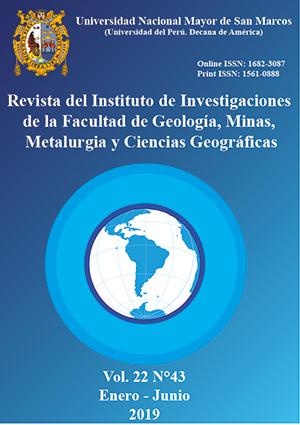Elaboration of bioplastics and determination of their biodegradability - Laboratory proyect
DOI:
https://doi.org/10.15381/iigeo.v22i43.16691Keywords:
Bioplastic; waste; potato; ISO 17556; biodegradationAbstract
The purpose of the research project was to make bioplastic from potato starch, which was extracted from the waste of the peeling process by using an industrial peeler of low capacity. Likewise, it also sought to determine and evaluate the biodegradability of the elaborated bioplastic, for which the ISO 17556: 2012 Standard was taking as reference. The investigation had three stages, the first one was the extraction of the starch. In this stage, the variation of the temperature and the antioxidant additive sodium metabisulfite in the process was evaluated. The test carried out at room temperature and with 3% sodium metabisulfite resulted in obtaining a greater quantity of starch, so those quantities were used in the elaboration of the bioplastic. The starch presented a ratio of 26.21 / 73.79 amylose/amylopectin and a spectrum similarity of 89.8% with respect to the soluble starch spectrum. The second stage was the elaboration of the bioplastic by the chemical hydrolysis of the starch and the addition of water and glycerol as plasticizers. The elaboration of the bioplastic took as variables the amounts of plasticizers, being the most resistant the bioplastic made with 5 ml of glycerin and 3 ml of acetic acid, this reached a maximum effort of 1.47 MPa and a maximum elongation of 19.99%. Likewise, an infrared analysis (FTIR) was carried out, which showed the formation of characteristic bonds of the biopolymer. Finally, the third stage was the biodegradability test of the bioplastic using compost as a degradation medium, negative control of low-density polyethylene, positive control of cellulose and the bioplastic sample to be tested. The results indicated 64.21% biodegradation for bioplastic, 63.21% for cellulose, 6.95% for low-density polyethylene (LDPE) and 0.83% for white.
Downloads
Published
Issue
Section
License
Copyright (c) 2019 Paola Meza R., Lawrence Quipuzco U., Victor Meza C.

This work is licensed under a Creative Commons Attribution-NonCommercial-ShareAlike 4.0 International License.
AUTHORS RETAIN THEIR RIGHTS:
a. Authors retain their trade mark rights and patent, and also on any process or procedure described in the article.
b. Authors retain their right to share, copy, distribute, perform and publicly communicate their article (eg, to place their article in an institutional repository or publish it in a book), with an acknowledgment of its initial publication in the Rev. Inst. investig. Fac. minas metal cienc. geogr.
c. Authors retain theirs right to make a subsequent publication of their work, to use the article or any part thereof (eg a compilation of his papers, lecture notes, thesis, or a book), always indicating the source of publication (the originator of the work, journal, volume, number and date).






